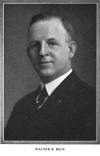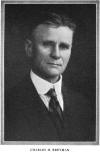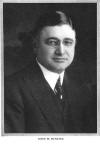|
~ Source:
TOLEDO
and
LUCAS COUNTY, OHIO
1623 - 1923
-----
VOL. II
-----
ILLUSTRATED
-----
Chicago and Toledo
The S. J. Clarke Publishing Company
1923

< CLICK
HERE to RETURN to 1923 BIOGRAPHICAL INDEX >
< CLICK HERE to RETURN to LIST of
HISTORIES & BIOGRAPHICAL INDEXES >
| |
WILLIAM T. BAILEY
Among the successful business enterprises of Toledo, in
the wholesale trade, is The Ainsworth Shoe Company, of which
William t. Bailey is the vice president and general
manager, and the development and prosperity of the
corporation are largely attributable to his initiative
spirit and administrative powers.
William T. Bailey was born in Ingham county,
Michigan, Mar. 9, 1878, and is a son of James W. and
Kitty (Taylor) Bailey, the former a native of New York
state, and when a young man he located in Ingham county,
where he has since been connected with the lumber industry.
William T. Bailey acquired his education in the
public schools of Ingham county, Michigan, and his initial
commercial experience was obtained with the wholesale shoe
house of G. E. Creighton of Lynn, Massachusetts.
Eventually he became a traveling salesman, covering the
state of Nebraska, and for twelve years was thus occupied.
He located at Toledo in 1911, forming a connection with The
Ainsworth Shoe Company, wholesale dealers of high grade
shoes, and in 1916 was made vice president and general
manager of the firm, which offices he is now filling.
Mr. Bailey was married in Toledo on the 10th of
July, 1905, to Miss Nellie De Soe, a daughter of
Orin and Emma De Soe, well known residents of this city.
Mr. and Mrs. Bailey have a daughter, Barbara Ruth,
who was born Oct. 9, 1919.
Mr. Bailey gives his political support to the
republican party and he is a member of the Toledo, Toledo
Automobile and Toledo Commerce clubs and a director of the
Dime Savings Bank. In Masonry he has attained the
thirty-second degree, belonging to both the York and
Scottish Rites and is also a shriner. Mr.
Bailey's business success affords an excellent
illustration of what can be accomplished through untiring
effort and determined purpose, when guided by intelligence
and sound judgment, and he ranks with the representative
business men of the city.
Source: Toledo and Lucas County, Ohio 1623-1923
- Vol. II - Publ. 1923 - Page 252 |

Walter B. Beck |
WALTER BRIM
BECK Source: Toledo and Lucas
County, Ohio 1623-1923 - Vol. II - Publ. 1923 - Page 650 -
653 |

Charles H. Breyman |
CHARLES H.
BREYMAN
Source: Toledo and Lucas County,
Ohio 1623-1923 - Vol. II - Publ. 1923 - Page 640 - 641 |
| (Portrait) |
CLARENCE BROWN.
Clarence Brown, whose entire career reflected
credit and honor upon the bar of Ohio during the long years
of his practice in Toledo, was born in Massillon, Ohio, Feb.
17, 1852, and was a son of Isaac H. and Elizabeth
(Wheeler) Brown. He received his early education
in the public schools of his native city and at the age of
twenty years began the study of law in the offices of
Scribner & Hurd at Toledo. Two years later he was
admitted to the bar and then began, in 1874, the practice of
law in this city, continuing as a distinguished and
representative member of the bar here to the time of his
death, which occurred July 30, 1918.
In the year 1879 Mr. Brown was married to
Miss Carrie Luce, a daughter of the late Hon. Charles
L. Luce of Toledo, who survives him.
Mr. Brown was frequently called to public office
in connection with the profession. He served for four
years, from 1875 until 1879, as assistant city solicitor
under Hon. Frank Hurd and General
J. Kent
Hamilton, successively. In 1881 he was elected
city solicitor and made a most creditable record in that
position, faithfully defending the interests of the
municipality in every way. For several years he was
lecturer upon medical jurisprudence in the Northwestern Ohio
Medical College and proved a most capable educator through
the readiness and clearness with which he imparted to others
the knowledge that he had acquired. A brilliant and
illuminating orator, a keen logician, an effective persuader
and therefore a leader; imbued with high ideals, a most
vigorous hater of shams and hypocrisies, and a consummate
master of every subject upon which he consented to speak, he
was in great demand for addresses and arguments upon a vast
variety of topics.
Mr. Brown was an eminently accomplished and
successful advocate, an expert examiner and a master of
cross-examination. Having a thorough knowledge of his
own case and an instant appreciation of every weak
development in that of his adversary, his conduct of a trial
was always masterly and his arguments, whether to judge or
jury, were splendidly effective. He often boldly
disregarded conventional methods, as when in a crim, con.
trial, in which he represented the plaintiff, he called as
his first witness and a great length examined the defendant
himself, an innovation amply justified by the result.
In 1885 Mr. Brown was retained as counsel for a
committee of bondholders, who thereafter purchased what has
since been familiarly known as the Clover Leaf Railroad
extending from Toledo to St. Louis, and from that time until
his death he was the general solicitor of the successive
corporations owning and general counsel for the receivers
operating that railway. In such capacities he
conducted, to the entire satisfaction of his clients, a vast
variety of involved litigation. His logical mind,
profound knowledge of legal principles and instant
application of them to novel conditions, made him singularly
happy in the making first impressions. Such actions,
of vital importance, arose in the construction of the
Manufacturers and Toledo Terminal Railways, in the
acquisition by the Hocking Valley Railroad of extensive
terminals in East Toledo, and in contests over property
rights in subterranean streams, and over the powers of a
municipality to build lines for piping natural gas from
productive fields and to assess upon abutting properties the
damages awarded its owners, either upon a change of a street
grade or for opening and extending a street. Some of
such actions received very wide attention and brought from
attorneys in different parts of the country many requests
for Mr. Brown's briefs.
It was, however, as counsel that Mr. Brown
achieved his greatest though less conspicuous success.
During his later years he appeared very rarely in the
courts. He was a save and sane adviser, keeping
clients out of litigation. Moreover, he had executive
and financial ability of a very high order. At the
time of his demise he was president of The Owens
Bottle Machine Company and president of the Toledo Times
Publishing Company. He was also vice president of the
Toledo Glass Company, the Libbey-Owens Sheet Glass Company
and the Owens European Bottle-Machine Company, as well as a
director of the Hocking Valley Railway and also of the Ohio
State Telephone Company. Outside of the domain of business
Mr. Brown had many and varied interests. He was
a trustee of the Toledo Museum of Art, a member of the
advisory committee of the Toledo Hospital, a director of the
Castalia Trout Club and the Toledo Riding Club and a member
of many other clubs, including the Toledo, Toledo Country,
Commerce and Yacht clubs, the Columbus Club and the Ottawa
Shooting Club.
An active member of the republican party, he served as
one of the early presidents of the Ohio League and was a
delegate to the republican national convention in 1888.
Mr. Brown traveled extensively throughout the United
States, Europe and South America. His favorite sport
was fishing and he was often active at the Castalia Trout
Club and fished many trout streams. He was one of
three lessees of a salmon stream in eastern Quebec, visiting
it each year for a few weeks, and he also made annual trips
to Florida for tarpon fishing.
He contributed largely, often in the name of others and
often anonymously, to public and private charities.
the wide scope of his sympathies is to some extent indicated
by his will, in which, after making ample provision for
Mrs. Brown, he bequeathed sums ranging from five hundred
to fifty thousand dollars to thirty-six individuals,
including relatives, partners, friends and employes, and the
residue of his estate, estimated at one million dollars, in
trust, and income to be paid to Mrs. Brown during her
lifetime and the capital to be, after her death, paid in
various proportions to the Toledo, St. Vincent's, Mercy,
Maternity and Children's Hospitals, the Toledo Museum of
Art, the local Young Men's and Young Women's Christian
Associations, the Red Cross, the Salvation army, the Flower
Deaconess Home, the Toledo Newsboys Association, the Old
Ladies' Home, the District Nurses Association, the
Federation of Jewish Charities, the Little Sisters of the
Poor, the Colored Working Girls Home, the Old Adams Street
City Mission, the North Toledo Settlement, the Florence
Crittenden Home, the Luella Cummings Home and the Thalian
Society. Thus his good works follow him and those who
are benefiting by his benefactions rise up and call him
blessed.
Source: Toledo and Lucas County, Ohio 1623-1923 - Vol.
II - Publ. 1923 - Page 22 |

John W. Bunting |
JOHN WELLINGTON
BUNTING Source: Toledo and Lucas
County, Ohio 1623-1923 - Vol. II - Publ. 1923 - Page 626 -
627 |
.
|

![]()
![]()

![]()
![]()